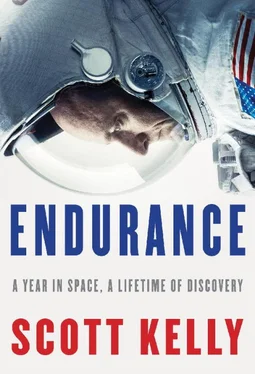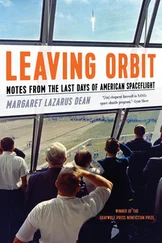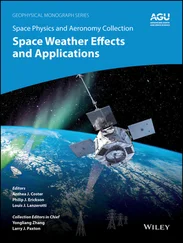My tumultuous relationship with carbon dioxide has been going on as long as I’ve been flying in space. On my first shuttle mission, which was seven days, I was responsible for changing the lithium hydroxide canisters on board that scrubbed the CO 2from the air. I remember each time I changed the canisters, once in the morning and once at night, I would become aware soon after how fresh the air was—only then did I realize that we had been breathing bad air. Part of our training in advance of flying on the shuttle was meant to let us experience and recognize the symptoms of high CO 2; we each went into a booth in the flight medicine clinic to put on a breathing mask that gave us slowly increasing levels of carbon dioxide.
On my second flight into space, again on the space shuttle, I became more aware of how CO 2was affecting me and talked with my crewmates about their symptoms. I could pinpoint those moments when the CO 2was the highest just from the way I felt. I decided to make an effort to start a more serious conversation about its effects. A new space station program manager had just been appointed, and soon after I was back on Earth I helped arrange to bring him on a visit to a Navy submarine under way in the Florida Straits. I thought the submarine environment would be a useful analogy for the space station in a number of ways, and I especially wanted my colleagues to get an up-close look at how the Navy deals with CO 2. What we learned on that trip was illuminating: the Navy has their submarines turn on their air scrubbers when the CO 2concentration rises above two millimeters of mercury, even though the scrubbers are noisy and risk giving away the submarine’s location. By comparison, the international agreement on ISS says the CO 2is acceptable up to six millimeters of mercury! The submarine’s chief engineering officer explained to us that the symptoms of high CO 2posed a threat to their work, so keeping that level low was a priority. I felt that NASA should be thinking of it the same way.
When I prepared for my first flight on the ISS, I got acquainted with a new carbon dioxide removal system. The lithium hydroxide cartridges were foolproof and reliable, but that system depended on cartridges that were to be thrown away after use—not very practical, since hundreds of cartridges would be required to get through a single six-month mission. So instead we now have a device called the carbon dioxide removal assembly, or CDRA, pronounced “seedra,” and it has become the bane of my existence. There are two of them—one in the U.S. lab and one in Node 3. Each weighs about five hundred pounds and looks something like a car engine. Covered in greenish brown insulation, the Seedra is a collection of electronic boxes, sensors, heaters, valves, fans, and absorbent beds. The absorbent beds use a zeolite crystal to separate the CO 2from the air, after which the lab Seedra dumps the CO 2out into space through a vacuum valve, while the Node 3 Seedra combines oxygen drawn from the CO 2with leftover hydrogen from our oxygen-generating system in a device called Sabatier. The result is water—which we drink—and methane, which is also vented overboard.

Terry Virts and me working on the Seedra in the Japanese module of the ISS. Credit 6 ILLUSTRATION CREDITS Nathan Koga 1, 2, 5, 6, 7, and 8: NASA; 3 and 4: NASA/Scott Kelly Illustrations NASA 9 and 10; Scott Kelly 11 and 12, U.S. Navy 13; NASA 14; NASA 15 and 16; NASA 17 and 18; NASA 19 and 20; NASA 21 and 22; Scott Kelly 23, Stephanie Stoll/NASA 24, NASA 25; NASA/Bill Ingalls 26, NASA 27; NASA 28, NASA/Bill Ingalls 29; NASA/Bill Ingalls 30, NASA 31; NASA 32, NASA/Bill Ingalls 33; NASA/Bill Ingalls 34 and 35; NASA/Bill Ingalls 36, NASA 37; NASA 38 and 39; Scott Kelly/NASA 40, NASA 41; NASA 42, NASA/Scott Kelly 43; NASA 44, NASA/Scott Kelly 45; NASA/Scott Kelly 46, NASA 47; NASA/Scott Kelly 48 and 49; NASA/Scott Kelly 50 and 51; NASA/Bill Ingalls 52 and 53; NASA/Bill Ingalls 54; NASA 55
The Seedra is a finicky beast that requires a lot of care and feeding to keep it operating. It wasn’t until I was a month or so into my first mission aboard the space station that I started to correlate the symptoms I was feeling to specific levels of CO 2. At two millimeters of mercury I feel okay, but at around three I get headaches and start to feel congested. At four, my eyes burn and I can feel the cognitive effects. If I’m trying to do something complex, I actually start to feel stupid, which is a troubling way to feel on a space station. Above four millimeters of mercury, the symptoms become unacceptable. The levels can creep up for different reasons. Sometimes the Seedra has to be shut off because the space station’s orientation isn’t allowing us to collect enough solar energy to power it. For example, when a Progress resupply spacecraft docks, the solar arrays need to be turned edge on so their surface area doesn’t get blasted by its thrusters. At other times there’s no clear reason for Seedra going on strike. Sometimes, it’s just broken.
Much of the management Seedra demands can be done from the ground, which is true for a lot of the hardware up here. Mission control can send a signal to the equipment, using the same satellites we use for email and phone calls. But at times, more serious hands-on maintenance by astronauts is required. The repair process isn’t simple. Seedra has to be powered down and allowed to cool. Then all the electrical connectors, water-cooling lines, and vacuum lines at the bottom of the rack the Seedra sits in have to be removed. All of the bolts holding it in place must be removed so it can slide out. On my previous mission, when I gave Seedra a good tug, it didn’t budge. It felt as if it were welded in place. I had to call to the ground for help, and they had no clue. Many meetings were called over the next few days at the Johnson Space Center while specialists tried to work through the problem.
In that instance, I went over all the bolts again and found one just hanging by a single thread. Problem solved. I pulled the beast out and eventually had to remove all the insulation to expose more electrical connectors, more water lines, and Hydro Flow connectors, which are notoriously tricky to mate. Working on a complex piece of hardware in space is infinitely harder than it would be on Earth, where I could put down tools and parts and they’d stay put. And there are so many complex pieces of hardware up here—NASA estimates that we spend a quarter of our time on maintenance and repairs. The hardest part of repairing the Seedra is replacing all the insulation, sort of like doing a huge 3-D puzzle with all the pieces floating. When we started it up again, it worked. Kelly 1, Seedra 0. I had no idea what it still had in store for me.
On this mission, the two Seedras have been giving us new issues to deal with. The one we use most, in Node 3, has been shutting down when its air selector valves, which are moving parts, get gummed up with zeolite and stick in the wrong position. The Seedra in the lab has an intermittent electrical short that we can’t quite pin down. Sometimes, over the course of a day, the CO 2level will slowly start to rise, especially when someone is exercising. As the day goes on, I’ll feel congested, with burning eyes and a mild headache. I’ve been using Sudafed and Afrin to fight the symptoms, but these are temporary fixes, and I will quickly develop tolerances. A few days ago, I asked Terry and Samantha how they have been feeling, and they both said they had noticed that when the CO 2was high they didn’t feel especially sharp cognitively. I’m frustrated that we can’t seem to get any urgency on this issue from the ground.
Читать дальше













